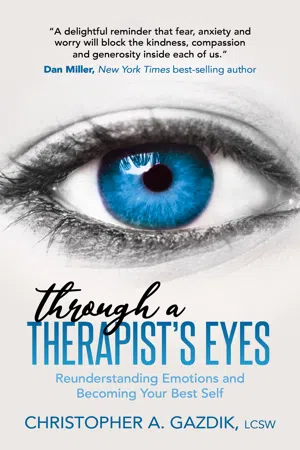
Through a Therapist's Eyes
Reunderstanding Emotions and Becoming Your Best Self
- English
- ePUB (mobile friendly)
- Available on iOS & Android
Through a Therapist's Eyes
Reunderstanding Emotions and Becoming Your Best Self
About this book
Through a Therapist's Eyes helps individuals grow as a person and equips them to tackle the challenges of life and flourish emotionally in all that they accomplish.
Universally, human beings are said to have what is referred to as the Human Condition. This human condition refers to the massive set of feelings and emotions including insecurities, hurts, and hang-ups that have a tendency to arrest development and suffocate people emotionally. In Through a Therapist's Eyes, Christopher A. Gazdik, LCSW presents powerfully unique information he has developed over his 25 years of being a therapist in order to help people through the tough moments and situations they find themselves in throughout the journey of life. Chris provides tools people need to manage these tough life circumstances which are synthesized from specific moments he experienced in various individual psychotherapy experiences. Through a Therapist's Eyes helps people destroy insecurities, manage fears, and identify personal strengths and methods to cope with the life circumstance they might find themselves in.
Frequently asked questions
- Essential is ideal for learners and professionals who enjoy exploring a wide range of subjects. Access the Essential Library with 800,000+ trusted titles and best-sellers across business, personal growth, and the humanities. Includes unlimited reading time and Standard Read Aloud voice.
- Complete: Perfect for advanced learners and researchers needing full, unrestricted access. Unlock 1.4M+ books across hundreds of subjects, including academic and specialized titles. The Complete Plan also includes advanced features like Premium Read Aloud and Research Assistant.
Please note we cannot support devices running on iOS 13 and Android 7 or earlier. Learn more about using the app.
Information
Table of contents
- Cover
- Title
- Copyright
- Contents
- Acknowledgments
- Introduction
- The Self
- Chapter 1: Fears are usually irrational.
- Chapter 2: Insecurities can make us delusional.
- Chapter 3: Insecurities are a cancer to the human spirit.
- Chapter 4: Guilt, fear, and insecurities twist reality into negative thinking.
- Chapter 5: Emotional Fact: We will cope with feelings productively or destructively.
- Chapter 6: Focus on encouragement from others or learn to encourage ourselves with positive thinking.
- Chapter 7: Depression can create a predisposition to negative thoughts but not a destination of negative thoughts.
- Chapter 8: Happy people do good work.
- Chapter 9: To give is good but to over-give can be destructive. It is nice to be nice, but is it better to be good to yourself.
- Chapter 10: Why resolve feelings?
- Chapter 11: Accepting things is a part of your emotional growth
- Chapter 12: Some people falsely believe they don’t have feelings or emotional experiences.
- Chapter 13: Expressed emotion is positive and fresh. Internalized emotion is stagnated emotion, often creating bad feelings, becoming “moldy or stale baggage.”
- Chapter 14: How do we handle stress? We feel what we focus on.
- Chapter 15: Life is too short to not be happy.
- Chapter 16: The value of working through life events is high...
- Chapter 17: It’s not easy to understand how to be a man or a woman
- Chapter 18: When we are the angriest, the more powerful “I statements” become.
- Chapter 19: When you feel the urge to take action, do so. Dwelling on things tends to create anxiety.
- Chapter 20: Humble people are happy people.
- Chapter 21: There is a need for balance between holding someone accountable while maintaining objectivity and not harboring resentment.
- Chapter 22: Grief: In regard to loss in our lives, we can logically plan for an event, but emotionally, it is still shocking.
- Chapter 23: The body goes as the brain thinks.
- Chapter 24: Boundaries are important markers between others and us. “With or without trepidation let others know where you stand.”
- Chapter 25: We are constantly a new or reconstituted self. We are not our “old self.”
- Chapter 26: Life is one big learning process with many opportunities to learn
- Chapter 27: We experience most what we focus on the most.
- Chapter 28: Taking things in small pieces and having small goals makes big things easier.
- Chapter 29: Codependence: Fixing other people’s problems so they will be okay, making you feel okay.
- Chapter 30: When our critical selves come out, it wears us out and wears others down
- Chapter 31: Focus on time. Flexible thought in the present is required to let go of regret from the past or worry about doom in the future
- Chapter 32: We choose what to focus on. What we focus on, in part, determines how we feel.
- Chapter 33: Realize change does not happen to us. It happens with us—we get to participate.
- Chapter 34: We can change our inner dialogue and cope with past hurts.
- Conclusion
- Endnotes
- About the Author